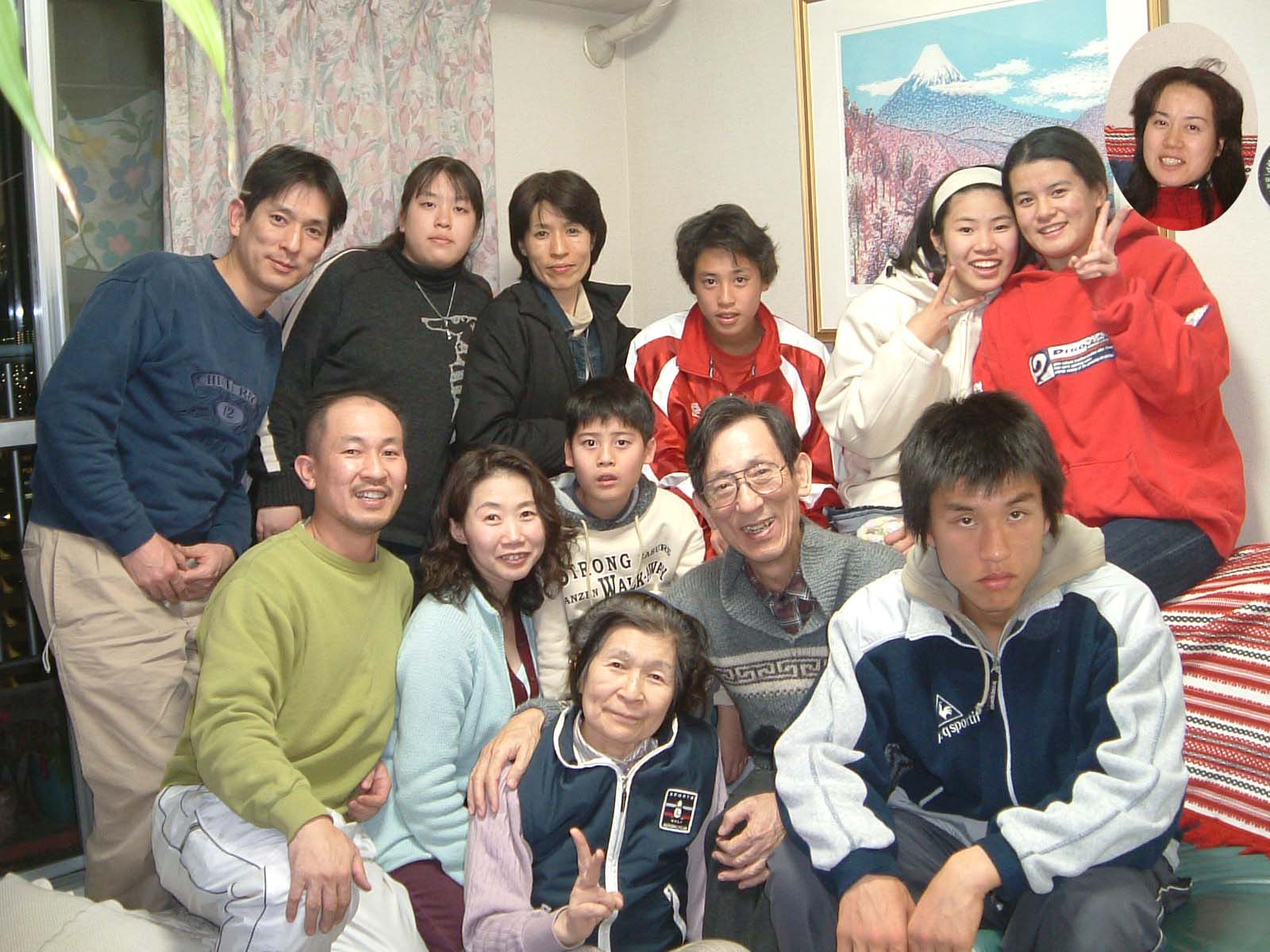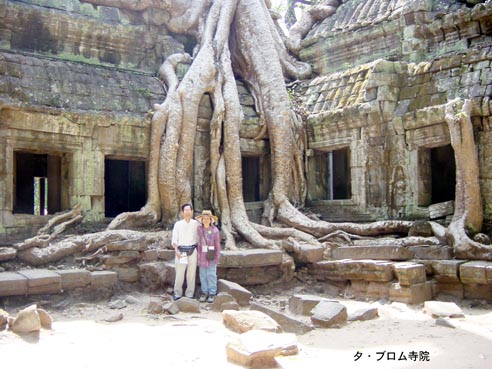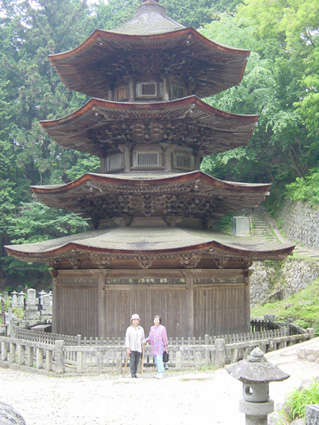English Page. . . . . . . . . .
ToJapanese Page
Dear friends(sorry not updated since 2004),
In spite of the war in Iraq, the terrorist bombing worldwide and the fear against SARS, our life here has been going on as usual, quietly and peacefully, but with some activities. In March, we visited Angkol Wat, Cambodia and Ayutaya historic site, Thailand, just before SARS broke out at these areas.

The area of Angkol Wat (wat=temple) was ruled by Khmer kingdom since 9 C to 13C. Angkol Wat built in 12C is the biggest and most brilliant temple among those made by the Khmer people. However, after Thai army conquered the kingdom in 13C, those temples were abandoned in the jungle until 1860 when a French explorer relocated them. Since then, Angkol Wat and many other temples had been excavated and preserved by French governments till Cambodia gained independence in 1953.

Most temples were badly damaged during the 600 years lonely life in jungle and during the civil war. One of the most impressive temples is Ta Prhom, where giant Banyan trees grew up through the temple, with their huge roots resting on the ground and on the roofs of the temple. The temple is now a part of the trees. The temple and trees (shown above) have been preserved almost exactly as they were found by the French explorer in 1860s.
In Nov.3 to 8, we joined the field trip to Kunming, Dali and Tengchong, Yunnan Province, China. Profs. Shen Zhaoli and Wang Yanxin and their colleagues organized this trip who made a proposal to organize the 12th International Symposium on Water -Rock Interaction in this area in 2007. Five members of the Working Group Executive Committee, including myself, were invited to join the trip and examine their proposals.

Yunnan Province is a dream land dotted by boiling hot springs and volcanoes (Tengchong), historic temples and buildings since Han dynasty, traditional cultures by many different minority groups, impressive stone forests made by eroded limestone and rice fields made on the mountain slopes forming many terraces. However, Yunnan Province is no exception to the recent developments in China.

The trip from Kunming to Tengchong, about 750km, took about 3 hard days in 20 years ago, but the high way system that will be completed within the next few months, will make it to 5 hours drive. During the trip, we again found that Chinese are hard walkers (also hard workers). Everywhere, we had to walk kilometers to reach the point of interests after the parking areas. This is good in one point that the points of interests are kept away from pollution from car exhaust. But for Sadako and myself, who are leading so lazy days at home, the exercise we had in Yunnan is more than we would have for the next ten years or so at home.
On our way back home, we spent the other 4 days at Guangzhou with our old Chinese friends, Drs. Wei Keqin and Chen Yuwei. They organized the 2nd China-Japan Joint Isotope Symposium there in 1989. We were impressed by the developments of the city during the last 14 years. Not only the city but also the Guangzhou Institute of Geochemistry where they used to work has been rejuvenated by young active scientists. I gave a lecture on the exploration of Mars for life. Otherwise, we enjoyed visiting various historic and modern spots of interest of the city, which were arranged by our friends. They took us to a narrow street where many small shops are selling jade stones. When you want to buy jade here, you must learn how to negotiate with shopkeepers about the price. Thanks to advice given by the local friends, I started with 200 yuan ($100=850 yuan) when a shop owner bit 2300yuan for a nice stone. Finally I got it for 300 yuan! But my friends were still unhappy with the price.
 In June, we drove to Kashio hotsprings, Nagano Pref. Japan, about 400km to the north of Tokyo to sample the springs water for 3He/4He analysis. After that we further spent three days driving around in Nagano City and Ueda City of the Pref. At Ueda, Ms Sakurada, a high school classmate of Sadako, who lives there for 25 yrs., welcome us to be our guide. We visited most of the famous historic temples and castles of the area. Shown below is the 3-storied tower of Daihoji Temple that was built in 1333 and is one of the 3 national treasures in Nagano Pref.
In June, we drove to Kashio hotsprings, Nagano Pref. Japan, about 400km to the north of Tokyo to sample the springs water for 3He/4He analysis. After that we further spent three days driving around in Nagano City and Ueda City of the Pref. At Ueda, Ms Sakurada, a high school classmate of Sadako, who lives there for 25 yrs., welcome us to be our guide. We visited most of the famous historic temples and castles of the area. Shown below is the 3-storied tower of Daihoji Temple that was built in 1333 and is one of the 3 national treasures in Nagano Pref.
My family has been doing well. Jun was recently shifted from the joint work on jet engines with GE in Cincinnati to a position for works of a wider angle. He now more often travels overseas to visit jet engine makers such as Rolls Royce in Britain, and some other companies in Spain, Belgium and Holland as well as USA. Saaya, a daughter of Jun and Erika is now in the 6th grade and keeps a strange rabbit. The small animal likes to dig a hole into ground, so Jun built a small rabbit house on his small garden. Two of our three grandsons are crazy about soccer. Yuuta, the elder one, the son of Kanako and Hirohisa Noguchi is going to graduate from a high school next spring. He has been playing soccer in a youth club belonging to a professional team and really wants to be a professional player. All of us hope that he applies for several professional teams' tests, and after being rejected by all of them, finally decides to go to a university. Ryo, a son of Ken and Yoshiko Sakai is a 8th grader and plays soccer in his school club. His team won the championship of Edogawa City and now waiting for the championship game for all Tokyo middle school teams. Sadako has been busy exchanging e-mails and letters with her friends of Taiwanese connection. She was born and raised till 10 yr. old in a small town in the western Taiwan. That was the time when Taiwan was under Japanese occupation. She wrote her memory of Taiwan in this website and it caught attention of those Japanese who had the same experience as Sadako. Most of them were living in the same town and commuting to the same elementary school as Sadako.